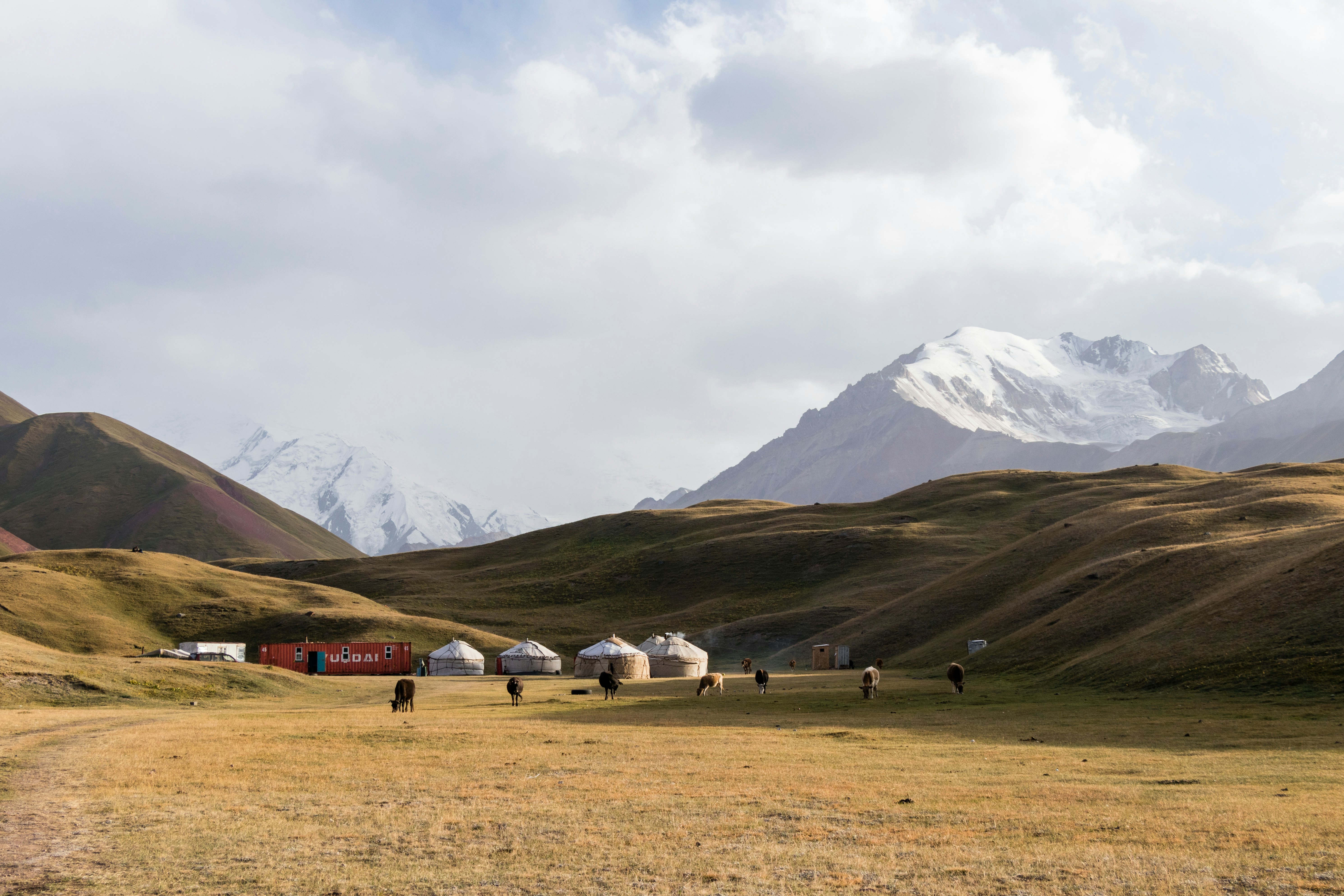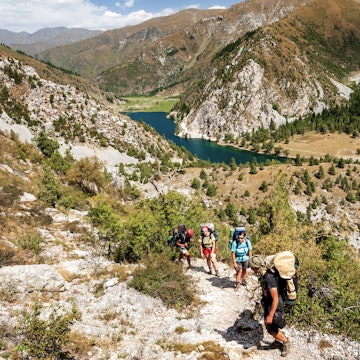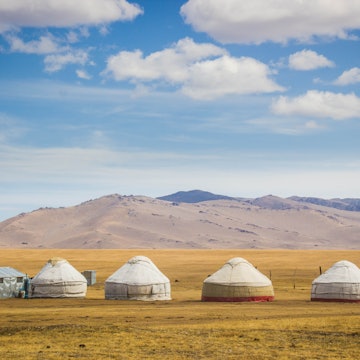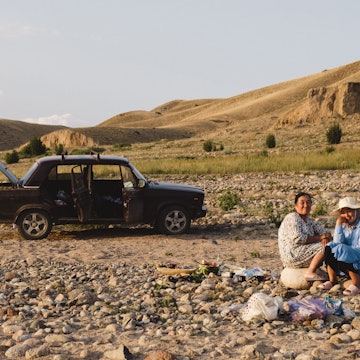

Horses taking a mid-trek break in the Alay Mountains. Jennifer Korn for Lonely Planet
“Horses are the wings of man.” So goes an ancient Kyrgyz proverb.
A visit to Kyrgyzstan is not complete without taking to horseback. Brimming with thousands of years of nomadic history and natural wonder – from jagged mountain peaks at breath-catching altitudes to impossibly blue lakes surrounded by wild walnut forests – the Central Asian country is oft revered as an ultimate destination for adventurous travelers. Those hoping to get a true sense of Kyrgyzstan’s unique past and persisting traditions will find that embarking upon a multi-day horse trek is the best way to do so.
Horse trekking, or traveling from yurt camp to yurt camp for several days through the wilderness on horseback, is both a nature-loving tourist’s dream and the backbone of Kyrgyzstan’s culture, economy and history. Whether you’re a seasoned horse-riding vet with years of experience or a newbie hoping to see the Kyrgyz world from the best vantage point, this is what you need to know when planning a trip.

Why are horses special to Kyrgyzstan?
Kyrgyzstan, a historically nomadic country, has relied on horses for transport and livelihood for thousands of years. For centuries, horses have supported drifting nomadic families, Silk Road merchants, clashing warriors and rural farmers, and they continue to play a crucial role in the lives of Kyrgyz people to this day. Horse meat is a culinary tradition in Kyrgyzstan, and Kok Boru, a traditional game best described as horse polo played with dead goats, is the national sport (Netflix released a documentary episode on the sport as part of their Home Game series in 2020).
Since gaining independence in 1992 after the fall of the Soviet Union, the country has come to view horses as synonymous with Kyrgyz statehood. Furthermore, horses are still seen in many more remote areas of the country as the most reliable and efficient mode of transport. Despite a rapidly transforming economy and bubbling urban centers like the capital city, Bishkek, the horse remains a steadfast cornerstone of modern Kyrgyzstan.
“The Kyrgyz people are synchronized with the horses. They are deeply connected to their soul,” said Azamat Zhumashov, CEO and founder of KAGAN Tours. “If in my mind or in my heart there is trouble, the horse will also get excited. If I am relaxed and enjoying myself, the horse is also in a good mood. There is a spiritual connection, a soul connection for Kyrgyz people. Horses are our greatest investment.”
Where should I go horseback riding in Kyrgyzstan?
Dominated by two major mountain systems (Tien Shan to the East and Pamir Alay to the southwest) that cover 90 percent of the country’s land, Kyrgyzstan has no shortage of beautiful places for a horse trek.
The Tien Shan, known locally as the Celestial Mountains, are home to some of the country’s most famous natural wonders. It’s the most popular destination for horse treks given its notable diversity in landscape and species. One could do a multi-day horse trek to captivatingly blue Song-Kol Lake or head through Jeti-Oguz for striking red canyon formations and lush, flower-speckled valleys. There are also vast, wildlife-filled forests, rushing rivers and hidden hot springs to be enjoyed on a Tien Shan horse trip.
Also popular is the Pamir Alay Mountain range. A bit rockier than the Tien Shan and known for its snowcapped peaks peering over dramatically steep valleys, this region can feel more rugged and remote. Horse trek options are aplenty, though many travelers opt to hike on foot in this region.

What are the best horse treks in Kyrgyzstan?
Whether you’re looking for a day on horseback or a multi-week adventure, these treks offer a glimpse into Kyrgyzstan’s physical and cultural beauty. Most treks are highly customizable, and tour companies offer a variety of lengths for each route.
The best horse treks in the Tien Shan
Song-Kol Lake: This is the most popular horse trek in the region and the best option for beginner riders. Treks will typically last 2-5 days and include stunning views of the alpine lake, towering mountain vistas and lush green forests.
Ala-Kol Lake and Altyn Arashan Valley: Treks to this area leave from Karakol, a hub for outdoor adventure brimming with local coffee shops, incredible Kyrgyz cuisine and backpacker hostels. The views are jaw-dropping, though the highlight may be a soak in the hot springs in Altyn Arashan alongside a plunge into the icy-cold Arashan River.
Jyrgalan: A once-prosperous Soviet mining town that has now become a hidden oasis for natural beauty. Near the comparatively busy Karakol, there are several routes you can take out of Jyrgylan on the back of a horse, with options ranging from 1-4 days.
Chon-Kemin Nature Park: Just 135km (84 miles) from Bishkek, Kyrgyzstan’s longest gorge is nestled between the two branches of the Tien Shan. Featuring a twisting river, countless grazing animals and hordes of fir trees, this relatively untouched region is a paradise for those looking to get truly off the grid. Tours start at one day, and longer treks often connect the park with a journey to Issyk-Kol Lake, the second largest alpine lake in the world.
Tash-Rabat to Chatyr Kol: This usually takes around five days, following the ancient Silk Road route in the far east, past green rolling hills, rocky mountain passes and the Tash Rabat caravanserai, a 15th-century stone-built building believed to have served as a rest stop for weary Silk Road merchants. To visit Chatyr Kol as part of your trek, a pre-obtained border permit is necessary. (Permits can take up to two weeks to obtain, and many tourist companies such as Kyrgyz Tourism and Too.kg offer assistance.)

The best horse treks in the Pamir-Alay
Tulpar-Kol to Peak Lenin Base Camp: If you’re headed to Kyrgyzstan with the hope of laying eyes on the infamous Lenin Peak, known as the world’s easiest 7000m (23,000 ft) peak to climb, this multi-day excursion takes riders through the truly wild Pamir region with a chance to spend the night at Base Camp.
Ak Tor Pass and Kum Bell Pass: Both Alay treks offer sweeping views of the rugged region and a chance to immerse yourself in the lives of local families who relocate to the mountains in the summer months.

…or maybe you prefer a walnut forest?
A markedly different option outside both ranges is the Arslanbob Walnut Forest. Estimated to be 50 million years old and home to around 130 varieties of nuts and fruit, it’s the largest forest of its kind in the world. Just 70km (44 miles) from Uzbekistan in the southwest Babash-Ata mountains, most people living in the area are ethnic Uzbeks who speak a local dialect, wear traditional clothing and share a distinct culture. Arslanbob Village serves as the main hub before you head into the forest. Notable horse excursions include the Sary-Chelek Trek and Toktogul Valley.
What tour operators should I organize with?
There are plenty of local and international tour companies organizing horse treks. Visit Alay is one of the most popular Kyrgyz-based entities, offering horse treks, as well as hiking treks and Pamir Highway tours. Other trusted operators include Gulsary Stables, Datka Travel and Kyrgyzstan Nomad Trekking.
Another option is Community Based Tourism Kyrgyzstan, which focuses on using a sustainable and holistic ecotourism approach to improve living conditions in remote areas, relying on local resources and manpower. You can either book ahead or directly at one of their local offices.
If you'd like more flexibility, you have plenty of options once you arrive in Kyrgyzstan. I booked my horse trek through a hostel two days before departure with Bulak Say Horseback Riding and Trekking after agonizing for weeks over the best route. It was magical.
Where do I start the treks from?
Most horse treks will leave from Bishkek, Karakol in the east or Osh in the southwest.
Getting to Karakol from Bishkek requires a 7-8-hour car ride, though the views of Issyk-Kol Lake are a nice distraction. There are also numerous spots to stop along the way, like Bokonbayevo, for a dip in the lake. Additionally, Karakol National Airport opened in late 2024, but flights from Bishkek are still few and far between.
Osh is more connected to Bishkek, with several flights a day between the two. It’s also possible to fly between Osh and Istanbul, making the southern region a bit more internationally accessible.

Where will I sleep on a horse trek?
Depending on the trekking company you use, you might stay in tents or a more traditional yurt camp. Staying at a yurt camp is experiencing Kyrgyz culture at its core. Yurts are so ingrained in the national identity that Krgyzstan’s flag features a red backdrop with a stylized tunduk (the top opening of a traditional yurt) in the center.
Yurt camps exist across the country in the summer season, tucked in riverside communities and jailoos (high mountain pastures) in the most isolated parts of the Kyrgyz landscape. Camps are collections of several yurts, with one typically serving as the kitchen and others as bedrooms or dining areas. The bathroom situation varies camp to camp, with some hosting full washrooms and others, well, less full.
Camps are largely family-run, and it’s common for children on summer break to help out with dinner and play with guests. I’ve watched a dance performance by the children of one camp, a volleyball tournament between two neighboring camps and a multi-instrument musical performance.

What will I eat on a horse trek?
A Kyrgyz meal is quite an event, even when miles away from civilization. At a tent site or yurt camp, meals will typically be served in a large banquet style, with tables laid out with traditional breads, fruit, cookies, jams and other snacks. The main dish will likely be a hearty bowl of rice with meat (beef, mutton, horse or yak) or a soup, though dietary restrictions can be honored. Breakfast might be a freshly made ayran (a fermented drink similar to yogurt) or some kind of eggs.
In the middle of a long day of horseback riding, it’s typical for touring companies to organize abundant picnic lunches. If you’re really lucky, you might get the chance to try Kumis, the traditional Kyrgyz alcoholic beverage made from fermented horse milk.
Do I need horseback riding experience?
Horse trekking in Kyrgyzstan is a safe activity for people of all equestrian skill levels. With tours led by practiced local horse guides – many of whom have been riding since nearly before they could walk – your only job is to listen to your leader and ride responsibly.
Novices may be placed with calmer horses and led by nose rein for the first few days as they get comfortable, while more advanced participants can take the chance to gallop freely in some of the world’s most beautiful fields.
“You’re in very capable hands of our local nomadic horsemen. They know your riding ability better than you do just by looking at you sitting in the saddle,” said Sam McManus, managing director of YellowWood Adventures, a travel company specializing in Kyrgyz horse tours.

What is the best time of year to go?
Horse trekking in Kyrgyzstan is only possible in the summer, as snow tends to pile up quite deeply in the colder months. Late May to early September is typical, though that timeframe shrinks in the more remote areas of the country. July and August are considered peak season.
What do I pack?
Regardless of when you plan your Kyrgyz horse adventure, you should be prepared for all weather possibilities in the mountains. Sturdy hiking boots are a must, as are layers, rain gear and sun protection. It can get very hot in parts of the country, and then it can cool down quickly. I also recommend bringing comfortable clothes for the evenings and some fun stuff to pass the time (cards, mini chess sets, journals and books are always a good idea).














